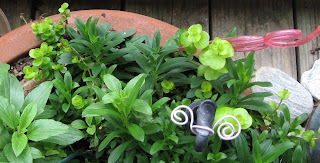
Oskar isn’t a puppy or a kitten but a red amaryllis bulb. Oskar is the variety name for this giant red and there are undoubtedly millions of them—but then there are millions of Davids and Anns too. One of my garden books says that the best bulbs are sold by name rather than color; the named ones are grown “vegetatively” while the ones sold by color are grown from seed and not as good a quality*. The Latin name for amaryllis,
Hippeastrum, is variably defined as knight on a horse, knight star or horse star (because it’s so big).
It’s been awhile since I’ve grown an amaryllis but I decided that it would be nice to have one for Christmas, and to share its growth with you.
I bought Oskar at a giant home improvement store, checking through several boxes to find one that had sprouted a bud rather than only leaves—sometimes if leaves come first, that’s all you get.
Boxes and boxes were stacked shoulder high; red, red & white striped, pink, pink & white, white & pink as well as white vied for attention. I leaned toward getting the deep pink but somehow, in my mind, amaryllis and red always go together—especially at Christmas. Besides, it had a gold-colored pot and I’ve inherited from my great grandmother, a fondness for gold paint.
My first memory of anything to do with amaryllis flowers is the name of the little girl in the movie
The Music Man. A pint-sized Ron Howard liked her but was too embarrassed to talk to her since his lisp made her name very difficult to say.

Much later, though as I said, I had grown several amaryllis plants and photographed them and had drawn and painted most any other kind of flower, for some reason I couldn’t draw or paint an amaryllis. But I persisted and accomplished this collage/painting The Lord Turns My Darkness to Light.
*
Crockett’s Indoor Garden, James Underwood Crockett; p.12













